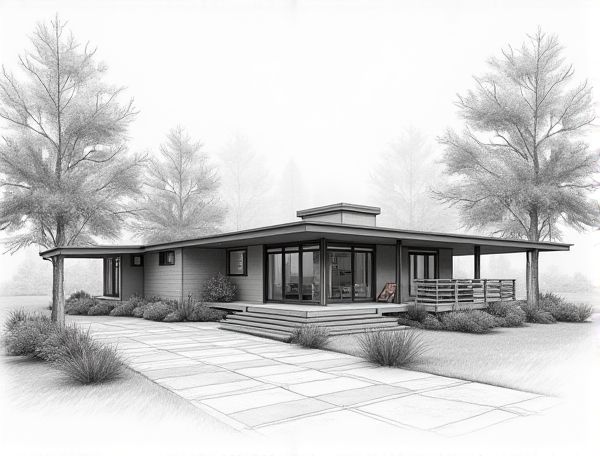
Photo illustration: Mid-century modern home design with biophilic integration
Mid-century modern home design emphasizes clean lines and functional forms, while biophilic integration brings natural elements indoors to enhance your living space with improved air quality and mental well-being. Discover how combining these styles creates harmonious environments that connect you with nature by reading more in the article.
Introduction to Mid-Century Modern Home Design
Mid-Century Modern home design features clean lines, organic curves, and an emphasis on functionality combined with minimalist aesthetics, originating in the mid-20th century from the 1940s to the 1960s. Your space can benefit from large windows, open floor plans, and a seamless connection between indoor and outdoor living, enhancing natural light and promoting simplicity.
Core Principles of Biophilic Integration
Biophilic integration in home design emphasizes natural light, organic materials, and greenery to enhance well-being and productivity. Incorporating elements such as indoor plants, natural wood textures, and ample daylight creates a harmonious connection between indoor spaces and the natural environment. You can elevate your living space by prioritizing these principles to foster relaxation and improve air quality.
Harmonizing Nature and Architecture
Integrating natural elements such as wooden textures, indoor plants, and large windows that frame outdoor views enhances the seamless connection between living spaces and the environment. Sustainable materials and biophilic design principles promote well-being while reducing the ecological footprint of modern architecture.
Sustainable Materials for Mid-Century Spaces
Incorporating sustainable materials such as reclaimed wood, bamboo, and recycled metal enhances the eco-friendly appeal of mid-century modern spaces while preserving their timeless aesthetic. These materials offer durability and natural textures that complement minimalist designs, promoting both environmental responsibility and elegant living environments.
Maximizing Natural Light and Views
Maximizing natural light and views enhances your home's ambiance and energy efficiency by strategically positioning windows, skylights, and glass doors to capture sunlight and panoramic scenes. Thoughtful placement of interior spaces near these openings allows you to fully enjoy outdoor vistas while reducing reliance on artificial lighting.
Indoor-Outdoor Living Concepts
Indoor-outdoor living concepts seamlessly blend interior spaces with natural surroundings through expansive glass walls, sliding doors, and open floor plans that enhance natural light and ventilation. Integrating materials like wood, stone, and greenery creates a harmonious flow that extends living areas into patios, gardens, or decks, maximizing comfort and connection to nature.
Incorporating Greenery and Living Walls
Incorporating greenery and living walls significantly enhances indoor air quality and creates a calming, natural ambiance within home interiors. Strategic placement of vertical gardens maximizes limited space while promoting sustainability and biophilic design principles.
Organic Shapes and Natural Textures
Incorporating organic shapes and natural textures in your home design enhances visual harmony by mimicking the irregular forms and tactile qualities found in nature. Curved lines and asymmetrical patterns create a soothing atmosphere, while materials like reclaimed wood, stone, and woven fibers add depth and authenticity to living spaces. Embracing these elements promotes a sustainable aesthetic, connecting your interiors to the environment and fostering a calming, grounded ambiance.
Color Palettes Inspired by Nature
Nature-inspired color palettes bring soothing shades like earthy browns, forest greens, and ocean blues into your home design, creating a calming and organic atmosphere. Incorporating these colors enhances spatial harmony and establishes a seamless connection between your interior and the natural environment.
Future Trends in Biophilic Mid-Century Modern Design
Future trends in biophilic mid-century modern design emphasize seamless integration of natural elements like indoor plants, organic materials, and large windows to enhance air quality and natural light. Advanced eco-friendly materials such as reclaimed wood and low-VOC finishes align sustainability with the iconic clean lines and functional aesthetics of mid-century modern architecture. Smart home technology increasingly supports biophilic principles by regulating indoor environments to mimic natural rhythms and improve occupant well-being.
 homedesy.com
homedesy.com